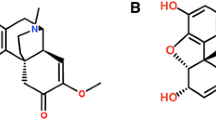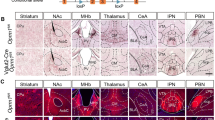Abstract.
Morphine-induced place preference was demonstrated recently in wild-type mice, whereas this conditioned behaviour was not observed in µ-opioid receptor-deficient mice. In the present study, we investigated locomotor effects of subcutaneously (s.c.) injected morphine as well as intracerebroventricular (i.c.v.) morphine self-administration in µ-opioid receptor-knockout mice.
After s.c. morphine injection, locomotor activity significantly increased in wild-type animals. As expected, in the self-administration test the rate of self-administration constantly increased in wild-type mice reflecting reward effects of morphine. This increase was independent of locomotor/motor activity. In contrast, self-administration rates and locomotor/motor activity significantly decreased in the receptor-deficient animals. It was shown that this aversive effect might partly be due to κ-opioid receptor interaction.
Similar content being viewed by others
Author information
Authors and Affiliations
Additional information
Electronic Publication
Rights and permissions
About this article
Cite this article
Becker, A., Grecksch, G., Brödemann, R. et al. Morphine self-administration in µ-opioid receptor-deficient mice. Naunyn-Schmied Arch Pharmacol 361, 584–589 (2000). https://doi.org/10.1007/s002100000244
Received:
Accepted:
Issue Date:
DOI: https://doi.org/10.1007/s002100000244




